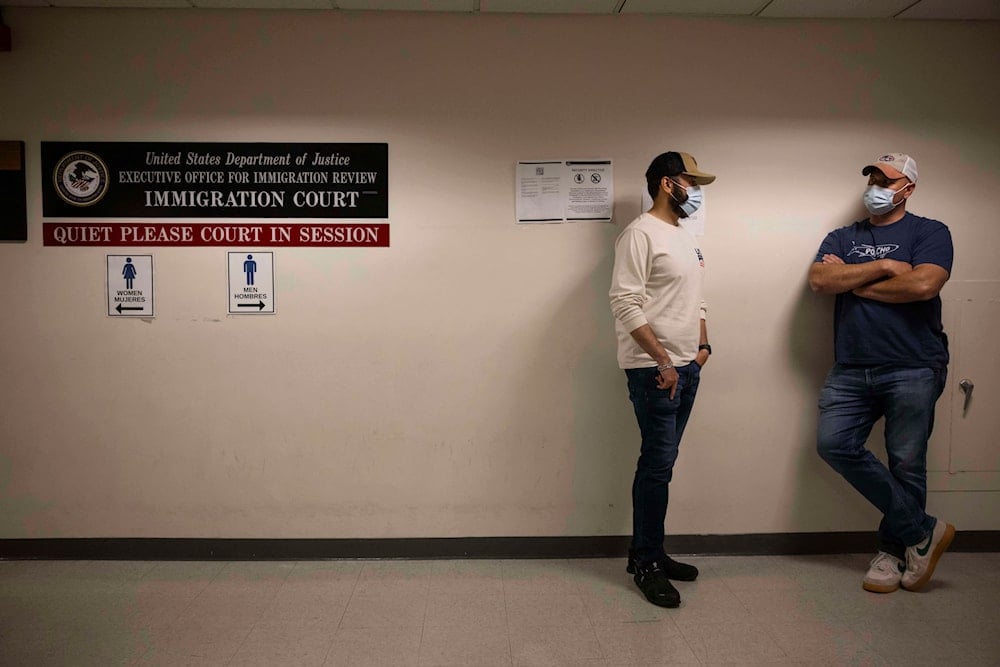Trump uses legal trick to deploy military for immigration
Pentagon reassigns 1,700 service members to support ICE operations by shifting from Title 10 to Title 32 status, a legal maneuver that allows the US military to directly engage with detainees while circumventing constitutional restrictions.
-

Plain clothes officers with Immigration and Customs Enforcement stand in a hallway outside an immigration courtroom at the Jacob K. Javits Federal Building in New York, Friday, June 6, 2025. (AP Photo/Yuki Iwamura)
The Pentagon has reassigned 1,700 service members to support US Immigration and Customs Enforcement (ICE) operations, shifting their command status from federal to state-level control. The transition from Title 10 to Title 32 status allows these personnel to operate under the authority of state governors while still receiving federal funding.
Crucially, this change enables them to directly engage with individuals in ICE custody, a move that circumvents the legal restrictions imposed by the Posse Comitatus Act, a US federal law that limits the powers of the federal government in the use of federal military personnel to enforce domestic policies within the US.
In the US legal framework, Title 10 refers to federal military authority, where service members are under the direct control of the president and the Department of Defense. Under Title 10, they are generally prohibited from engaging in domestic law enforcement.
In contrast, Title 32 places military personnel under the command of state governors, giving them greater flexibility to assist in law enforcement activities while still being funded by the federal government. This distinction is key to understanding how the military can now legally interact with detainees in ICE custody.
According to a Department of Defense statement, the shift affects 1,200 already deployed personnel and adds 500 new service members to the mission. This decision reflects a legal and strategic adaptation aimed at increasing military involvement in immigration enforcement without directly breaching federal laws.
Trump’s immigration agenda
This decision aligns with US President Donald Trump’s expanded immigration crackdown, part of his promise to launch "the largest deportation program in American history." In his inaugural address as the 47th president in January 2025, Trump pledged immediate action to halt illegal immigration and begin large-scale deportations.
Tom Homan, the administration’s appointed "border czar" and former acting ICE director, now oversees the deployment. Positioned within the White House, Homan has outlined aggressive objectives, including expanding ICE detention capacity to 100,000 beds and conducting 3,000 arrests per day.
Increased military involvement
Trump's immigration policies represent the most significant use of military resources for domestic immigration enforcement in modern US history. For the first time, military aircraft are being used for deportation flights, and service members are directly involved in ICE detention operations. Guantanamo Bay is being utilized for detaining migrants, and military bases are being converted into long-term detention facilities.
Previous administrations also employed National Guard troops at the border, such as during Operation Jump Start in 2006 and Operation Phalanx in 2010, but those missions were strictly limited to support roles and surveillance. In contrast, this new deployment integrates military personnel into direct enforcement roles.
Funding surge
In July 2025, Congress passed a reconciliation bill approving $170 billion in funding for immigration enforcement. This includes $45 billion for constructing new detention facilities and $75 billion for ICE operations. The funding increase marks a 265% rise in ICE’s detention budget and is expected to enable the detention of tens of thousands of immigrants daily.
Constitutional concerns
Legal experts have raised concerns over potential violations of the Posse Comitatus Act and the broader implications of militarizing immigration enforcement. The administration has invoked emergency powers and referred to an "invasion" at the southern border, prompting legal challenges. Some courts have already ruled such declarations unconstitutional.
The expanded enforcement strategy has instilled fear in immigrant communities and disrupted labor markets reliant on migrant labor, such as agriculture, construction, and hospitality. Despite increased ICE activity, arrest rates still fall short of the administration's daily target.

 4 Min Read
4 Min Read










